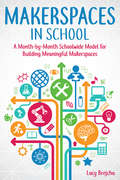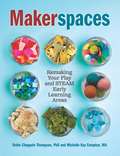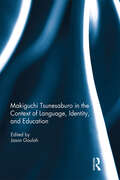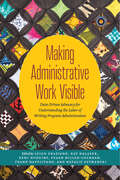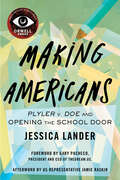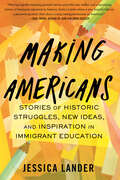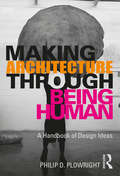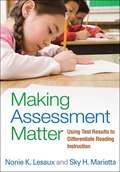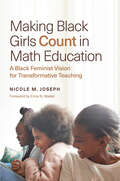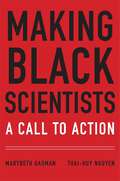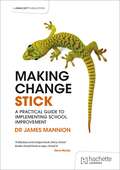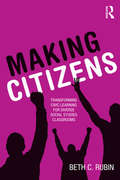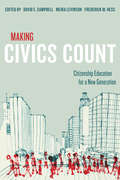- Table View
- List View
Makers, Crafters, Educators: Working for Cultural Change
by Manisha Sharma Elizabeth Garber Lisa HochtrittMakers, Crafters, Educators brings the do-it-yourself (DIY) ethos of maker and crafter movements into educational environments, and examines the politics of cultural change that undergird them. Addressing making and crafting in relation to community and schooling practices, culture, and place, this edited collection positions making as an agent of change in education. In the volume’s five sections—Play and Hacking, Access and Equity, Interdependence and Interdisciplinarity, Cultural and Environmental Sustainability, and Labor and Leisure—authors from around the world present a collage of issues and practices connecting object making, participatory culture, and socio-cultural transformation. Offering gateways into cultural practices from six continents, this volume explores the participatory culture of maker and crafter spaces in education and reveals how community sites hold the promise of such socio-cultural transformation.
Makerspaces in School: A Month-by-Month Schoolwide Model for Building Meaningful Makerspaces
by Lacy BrejchaOrganized into an easy-to-follow, month-by-month plan for implementation, this book provides field-tested and research-based knowledge that will serve educators as they create and maintain a meaningful Makerspace. Although science, technology, engineering, arts, and math have made huge gains in the past decade, STEAM jobs are not being filled at the rate they are being created or needed. Makerspaces in School promotes innovative thinking in students that fills this need. Through Makerspaces, project-based learning provides opportunities for credible, legitimate, and authentic growth and development. This book will allow any educator to walk away with a plan to create a Makerspace in his or her classroom or a school- or districtwide model that works for many. Makerspaces are very fluid places-each is unique in its own way!
Makerspaces in School: A Month-by-Month Schoolwide Model for Building Meaningful Makerspaces
by Lacy BrejchaOrganized into an easy-to-follow, month-by-month plan for implementation, this book provides field-tested and research-based knowledge that will serve educators as they create and maintain a meaningful Makerspace. Although science, technology, engineering, arts, and math have made huge gains in the past decade, STEAM jobs are not being filled at the rate they are being created or needed. Makerspaces in School promotes innovative thinking in students that fills this need. Through Makerspaces, project-based learning provides opportunities for credible, legitimate, and authentic growth and development. This book will allow any educator to walk away with a plan to create a Makerspace in his or her classroom or a school- or districtwide model that works for many. Makerspaces are very fluid places—each is unique in its own way!2020 Teachers' Choice Award for Professional Development Winner
Makerspaces, Innovation and Science Education: How, Why, and What For?
by Michael TanThis book provides an overview to a range of theories in science and technology that inform the different ways in which makerspaces can be educative. Makerspaces are an indispensable site for science, technology, engineering, and mathematics (STEM) instruction and pose novel risks and opportunities for STEM instruction. Educators are likely to reach towards activities that have a high degree of engagement, but this might result in observations like 'it looks like fun, but what are they learning?'. Beginning from the question of how we know what we know in science, the author asserts that understanding scientific knowledge requires us to know more than the abstract concepts typically presented in schools. The social and material aspects of knowledge are also important—these take the form of questions such as: What is the interplay between knowledge and power? How do we understand that we can have a ‘feel’ for materials and artefacts that we cannot completely describe in words? How do we know what ideas ought to be made real though technology and engineering? Significantly, this book also discusses the ethical dimensions of STEM education, in thinking about the kinds of STEM education that could be useful for open futures. This book will be useful to graduate students and educators seeking an expansive view of STEM education. More generally, these ideas outline a possible new strategy for a vision of school that is not merely training or preparing students for work. Education needs to also prepare students for sociopolitical participation, and with STEM being central to our contemporary lives, this book provides insights for how this can happen in makerspaces.
Makerspaces: Remaking Your Play and STEAM Early Learning Areas
by Robin Chappele Thompson Michelle Kay ComptonMakerspaces is a first-to-market resource for early childhood professionals that focuses on how to cultivate the maker mind-set in the youngest learners, how to engage young children in maker-centered learning, design and introduce makerspaces, and how to select/use open-ended tools and materials. Field tested in real classrooms, home settings, libraries, and museums, the authors have practical suggestions, student samples, implementers’ suggestions, photographs, anchor charts, and many other forms of documentation. Each chapter focuses on a different type of makerspace, details ways to successfully set up that makerspaces, offers provocation ideas for how to extend learning, and shows how educators can document evidence of how a child can develop a stronger growth mind-set by interacting with the makerspace.
Makiguchi Tsunesaburo in the Context of Language, Identity and Education
by Jason GoulahMakiguchi Tsunesaburo (1871-1944) was a Japanese schoolteacher, principal, educational philosopher, and Buddhist war resister. The progenitor of the value-creating (soka) pedagogy that inspires thousands of teachers worldwide and informs the network of 15 Soka schools, universities, and a women’s college across seven countries in Asia and the Americas, Makiguchi has emerged as an important figure in international education, curriculum studies, and instructional practice. Few educators in the global academy, however, know of Makiguchi’s extensive and lifelong work in language education. This edited volume, including a translation of an early Makiguchi essay heretofore unavailable in English, presents theoretical and empirical analyses of Makiguchi’s perspectives and practices relative to language, identity, and education in historical and contemporary contexts. First published as a special issue of Journal of Language, Identity and Education, this volume includes a new preface and three new chapters. Makiguchi Tsunesaburo in the Context of Language, Identity, and Education advances the field of Makiguchi studies and is indispensable for scholars and practitioners engaged in language and literacy education, international perspectives in education, and curriculum theorizing.
Makin' Room in the Inn: Christmas Hospitality Through an African American Experience
by S. Dianna Masters Henry L. Masters SR.Makin' Room in the Inn is a four-lesson Advent study that celebrates Christmas traditions and practice through the perspective of an African American family. Session titles, scriptures 1. Makin' Room (Luke 2:4-7) cultivating and living out hospitality in a diverse world 2. Makin' Do (Luke 2:21-24) trusting God as compared to trusting in wealth 3. Makin' Up (Matthew 2:19-21) learning the importance of forgiveness and reconnection 4. Makin' Time (Luke 2:15-19) understanding that the most precious gift is presence This Advent study celebrates the Christmas traditions and spirituality of black people in America, showing how African ethics and theology have a continuing influence. The study, however, relates to any group who has experienced rural to urban displacement, homecoming, and who strive to practice extended hospitality, especially during the Christmas season. This book includes a leader guide with: 1. An author’s introduction that sets the targeted issue in context. 2. Questions for the group that help stimulate discussion and their memories of family traditions and experiences of Christmas seasons. 3. A bibliography of helpful books on African American History, family and Christmas traditions. 4. More biblical and historical background information on African American Christmas celebrations, nativity art, etc. 5. Suggested format and time segments for group discussions. 6. Helpful teaching and learning techniques.
Making ALL Kids Smarter: Strategies That Help All Students Reach Their Highest Potential
by John P. DelandtsheerA hands-on guide for challenging ALL kids to think, create, and aspire! John DeLandtsheer brings 40 years of experience to this motivating resource that shows teachers how to raise the bar for all students. Included are strategies for differentiating instruction within the general classroom to challenge all learners with more rigorous content, showing teachers how to: Optimize learning by applying the six components of a brain-friendly classroom Build critical thinking skills with Socratic questioning and moral dilemmas Connect content through interdisciplinary themes Stimulate creativity with brainstorming activities Develop students’ research and study skills
Making Administrative Work Visible: Data-Driven Advocacy for Understanding the Labor of Writing Program Administration (G - Reference,information And Interdisciplinary Subjects Ser.)
by Leigh Graziano Kay Halasek Rebecca HudginsMaking Administrative Work Visible brings together voices from graduate students, associated faculty, administrative staff, and tenured and tenure-track faculty at community colleges, regional state universities, liberal arts colleges, private colleges, and research-intensive institutions across the country to speak to the challenges, both named and unnamed, faced by those who do writing program administration work. These authors call explicit attention to this work and examine WPAs’ lived labor experiences and research methodologies to truly understand the scope of lived WPA labor. The collection has three parts, each of which focuses on the most confounding challenges facing WPAs as well as the most compelling sites of their contributions to administration, labor in higher education, and the discipline’s collective obligation to forwarding the goals of social justice and advocacy: Advocating through Representations of WPA Labor, Advocating by Accounting for Time and Labor, and Advocating in and through Complex Institutional Contexts. The chapters use data to share and track the work functions, job titles, grand narratives, program assessments, tenure and promotion, email practices, and more undertaken by WPAs in their administrative capacities. Chapters also surface narratives for future data and studies to be done by other scholars. By taking up and answering questions about the range of WPA work—and the invisibility of much of that work—Making Administrative Work Visible creates avenues toward accounting for and acknowledging the complex activity systems in which WPAs lead the work of the university and advocate for data-driven strategies needed to sustain this foundational area of higher education. Contributors: Kamila Albert, Brooke Anderson, Sheila Carter-Tod, Amy Cicchino, Ana Cortés Lagos, Kristi Murray Costello, Jennifer Cunningham, Ryan Dippre, Kimberly Emmons, Genevieve García de Müeller, Jill Gladstein, Caleb González, Michael Healy, Lyra Hilliard, Kristine Johnson, Seth Kahn, Rita Malenczyk, Troy Mikanovich, Lilian Mina, Angela Mitchell, Greer Murphy, Kate Navickas, Michael Neal, Patti Poblete, Jan Rieman, Heather Robinson, Katelyn Stark, Mary Stewart, Natalie Stillman-Webb, Lizbett Tinoco, Lisa Tremain, Martha Wilson Schaffer
Making Americans: Plyler v. Doe and Opening the School Door
by Jessica LanderA vital history of Plyler v. Doe, the landmark case that affirmed every child's right to a public education in the US—no matter their immigration status For educators, advocates, and parents, with commentary from Congressman Jamie Raskin and from Gaby Pacheco, TheDream.US president and a proud Plyler studentEvery child, no matter their background or immigration status, deserves an education. The US Supreme Court upheld this in its 1982 decision in Plyler v. Doe, which affirmed public schooling as a right for all children. Yet today, our students, teachers, and school administrators face virulent anti-immigration rhetoric, unjust education policies, and classroom ICE raids.This essential history, excerpted from the award-winning book Making Americans, tells the inspiring story of the courageous families, lawyers, and judges who championed Plyler v. Doe. Teachers seeking to better support their immigrant-origin students will also find actionable resources like:A rapid response guide to supporting immigrant-origin students for teachers, school administrators, and district leadersA personal letter from Lídia Lopez, one of the mothers at the heart of the caseGuiding questions, primary sources, and recommended reading for teaching students about Plyler v. DoeIdeas for classroom activities to teach about immigrant education policy and the undocumented student experienceThis e-book also features a foreword from Gaby Pacheco, a proud Plyler student and president and CEO of TheDream.US, and an afterword from US representative Jamie Raskin, a champion of the US Constitution and students' First Amendment rights. This companion to Making Americans will empower educators and allies with the knowledge and the hope they need to protect their students' right to learn.
Making Americans: Stories of Historic Struggles, New Ideas, and Inspiration in Immigrant Education
by Jessica LanderA landmark work that weaves captivating stories about the past, present, and personal into an inspiring vision for how America can educate immigrant studentsSetting out from her classroom, Jessica Lander takes the reader on a powerful and urgent journey to understand what it takes for immigrant students to become Americans. A compelling read for everyone who cares about America&’s future, Making Americans brims with innovative ideas for educators and policy makers across the country.Lander brings to life the history of America&’s efforts to educate immigrants through rich stories, including these:-The Nebraska teacher arrested for teaching an eleven-year-old boy in German who took his case to the Supreme Court-The California families who overturned school segregation for Mexican American children-The Texas families who risked deportation to establish the right for undocumented children to attend public schoolsShe visits innovative classrooms across the country that work with immigrant-origin students, such as these:-A school in Georgia for refugee girls who have been kept from school by violence, poverty, and natural disaster-Five schools in Aurora, Colorado, that came together to collaborate with community groups, businesses, a hospital, and families to support newcomer children.-A North Carolina school district of more than 100 schools who rethought how they teach their immigrant-origin studentsShe shares inspiring stories of how seven of her own immigrant students created new homes in America, including the following:-The boy who escaped Baghdad and found a home in his school&’s ROTC program-The daughter of Cambodian genocide survivors who dreamed of becoming a computer scientist-The orphaned boy who escaped violence in the Democratic Republic of the Congo and created a new community hereMaking Americans is an exploration of immigrant education across the country told through key historical moments, current experiments to improve immigrant education, and profiles of immigrant students. Making Americans is a remarkable book that will reshape how we all think about nurturing one of America&’s greatest assets: the newcomers who enrich this country with their energy, talents, and drive.
Making Architecture Through Being Human: A Handbook of Design Ideas
by Philip D. PlowrightArchitecture can seem complicated, mysterious or even ill-defined, especially to a student being introduced to architectural ideas for the first time. One way to approach architecture is simply as the design of human environments. When we consider architecture in this way, there is a good place to start – ourselves. Our engagement in our environment has shaped the way we think which we, in turn, use to then shape that environment. It is from this foundation that we produce meaning, make sense of our surroundings, structure relationships and even frame more complex and abstract ideas. This is the start of architectural design. Making Architecture Through Being Human is a reference book that presents 51 concepts, notions, ideas and actions that are fundamental to human thinking and how we interpret the environment around us. The book focuses on the application of these ideas by architectural designers to produce meaningful spaces that make sense to people. Each idea is isolated for clarity in the manner of a dictionary with short and concise definitions, examples and illustrations. They are organized in five sections of increasing complexity or changing focus. While many of the entries might be familiar to the reader, they are presented here as instances of a larger system of human thinking rather than simply graphic or formal principles. The cognitive approach to these design ideas allows a designer to understand the greater context and application when aligned with their own purpose or intentions.
Making Art
by Ed BricklerA serious guide for the adventurous artist!Using the right tools and materials in the correct way can make a big difference in the success and enjoyment of your artistic process. This hands-on guide outlines the many options at your disposal, so that you can make the most of your art materials, your time in the studio, and your spirit of creative adventure.Bringing 25 years of expertise as an art materials consultant and workshop instructor, Ed Brickler covers everything from classic oil and watercolor techniques to contemporary uses of encaustics, acrylic gels, markers and more. His extensive knowledge and clear, step-by-step techniques will show artists of any level how to use various media to maximum potential.Explores 15 popular mediums--including graphite, pen & ink, oils, acrylics, watercolor, pastels, mixed media and more.Covers the various art materials and tools available on the market, offering expert advice on choosing the right supplies for a given medium.Takes the guesswork out of grounds, pigments, solvents and varnishes.Illustrates key techniques for each medium through 43 complete demonstrations and hundreds of close-up action photos. Based on the belief that a well-informed artist is a creative and productive artist, Marking Art will help you expand your repertoire of materials, approach your work with greater confidence, and give you the tools to express your artistic vision.
Making Art a Practice
by Cat BennettHelping artists catapult into further action, this guide is a treasury of insight and inspiration. Rather than focus on art techniques that build skills or overcome creative blocks through playful activities or writing, this guide walks the artist through exercises designed to develop the personal qualities critical to being an artist in the world, such as courage, the ability to look and see, and connection to the true creative self. This is a hands-on, experiential action book designed to get the reader creating art and exploring a variety of possibilities for being an artist. According to the teachings of this handbook, engagement with art is less about end results or products and more about the self-awareness and competence that frees the artist to seek out and create work that is vital. This is a rigorous programme that allows artists of any skill level to deepen their creative habits and be the best artists possible.
Making Assessment Matter
by Sky H. Marietta Nonie K. LesauxAll too often, literacy assessments are given only for accountability purposes and fail to be seen as valuable resources for planning and differentiating instruction. This clear, concise book shows K-5 educators how to implement a comprehensive, balanced assessment battery that integrates accountability concerns with data-driven instruction. Teachers learn to use different types of test scores to understand and address students' specific learning needs. The book features an in-depth case example of a diverse elementary school that serves many struggling readers and English language learners. Reproducible planning and progress monitoring forms can be downloaded and printed in a convenient 8 1/2" x 11" size.
Making Better Decisions Using Systems Thinking
by Bill Bryan Jaap SchavelingThis book provides a framework to help managers go beyond simply fighting fires every day, offering the tools to address the underlying causes of recurring problems and deliver long-term solutions. The most obvious part of any problem is the pain it causes. The desire to end the pain and find a solution - any solution - that will make it go away now is usually so great that it blinds managers to the underlying systemic cause of the problem. The result is that we 'solve' the problem today and then it comes back again tomorrow or next week, again and again. We are only addressing the symptoms but never understanding the cause - like picking the flower heads off weeds but not digging them out at the roots. Schaveling and Bryan offer the insights and tools managers and leaders need to achieve a longer term and more effective approach by stepping back and analysing the system as a whole. And at the heart of any system are human beings - notoriously short-term and pain-averse creatures who will behave in whatever way minimises pain today even at the expense of pain tomorrow. They show how to detect the behavior patterns that have become engrained in the organisation and which underlie complex situations so that root causes of problems can be identified. Once the system responsible for the problem is understood smarter decisions can be made to devise interventions that solve the core problem instead of wasting energy fighting the symptoms.
Making Black Girls Count in Math Education: A Black Feminist Vision for Transformative Teaching
by Nicole M. JosephMaking Black Girls Count in Math Education explores the experiences of Black girls and women in mathematics from preschool to graduate school, deftly probing race and gender inequity in STEM fields.Nicole M. Joseph investigates factors that contribute to the glaring underrepresentation of Black female students in the mathematics pipeline. Joseph&’s unflinching account calls attention to educational structures and practices that contribute to race- and gender-based stratification in science, technology, engineering, and mathematics disciplines. The author also disentangles a complex network of historical and sociopolitical elements that influence the perception and experiences of Black girls and women both inside and outside of mathematics education.In her clear-eyed assessment of the intersectional difficulties facing this marginalized group, Joseph offers a critical view of the existing mathematics education research, practice, and policies that have neglected Black girls and women; confronts the problematic history of mathematics education policy; and considers imbalances in the current teacher workforce in US mathematics programs. She then provides practical, actionable suggestions for reform.Joseph invites students, families, and educators, as well as researchers, policy makers, and other relevant stakeholders to disrupt systems, structures, and ideologies. She calls for an end to racism and sexism in many areas of mathematics education, including learning environments, curriculum design and implementation, and testing and assessments.An essential read for anyone concerned about supporting the mathematical learning and development of Black girls and women, this work advocates for coalition-building so that greater, more equitable opportunities for learning and engagement may be offered to Black female students.
Making Black Scientists: A Call to Action
by Marybeth Gasman Thai-Huy NguyenHistorically black colleges and universities are adept at training scientists. Marybeth Gasman and Thai-Huy Nguyen follow ten HBCU programs that have grown their student cohorts and improved performance. These science departments furnish a bold new model for other colleges that want to better serve African American students.
Making Change Happen in Student Affairs
by George S. Mcclellan Margaret J. Barr Arthur SandeenChange is inevitable. Managing change is a choice. Authored by three esteemed leaders in the field of studentaffairs, Making Change Happen in Student Affairs: Challenges andStrategies for Professionals is a thought-provoking andpragmatic guide to the increasingly complex challenges andexpectations that administrators face from both students and thepublic. Whether it's pressure to provide better programs andservices with fewer resources, or difficulties grappling witheconomic challenges and technological change, the book teaches howto become an effective leader and skillful strategist in order torespond to a rapidly changing landscape.Readers will learn to change their thinking about how theyapproach challenges by reframing their purpose, role, and functionas leaders. Each chapter includes specific concepts and tools thatcan be used to tackle the most complex campus issues and developeffective plans of action. You'll learn how to:Manage financial resources and supervise staff effectivelyAdvocate for specific students while still recognizingdiversity and maintaining service to allAdapt to institutional culture, ethics, values, and changes inleadershipUse technology as a tool to affect change on campusBy applying shared foundations, ethical principles, a richknowledge base, and experience, student affairs professionals candevelop powerful strategies to confront and resolve vexingproblems. With extensive examples and case studies that covera widearray of issues, this book is an essential read for those lookingto make a real difference in the lives of their students and thehealth of their institutions.
Making Change Stick: A Practical Guide to Implementing School Improvement
by James MannionImplementing change is a complex undertaking, and most school improvement initiatives fail to meet their stated aims. But it doesn't have to be this way. Drawing on a decade of research and development in schools around the world, Dr James Mannion introduces the Making Change Stick programme, a groundbreaking approach to implementing sustainable school improvement. This practical guide draws together insights from implementation and improvement science, equipping educators with practical tools and a systematic framework to lead effective change that positively impacts pupil outcomes. Inside, you'll find:- A step-by-step framework, including guidance on data collection, habit formation, and team collaboration- Detailed examples of effective change implementation, tailored to different school contexts- A range of tried-and-tested strategies to turn intentions into lasting improvement Whether you're a teacher, school leader, or policymaker, Making Change Stick offers essential tools to create a culture of continuous improvement and make a lasting difference.
Making Change Stick: A Practical Guide to Implementing School Improvement
by James MannionImplementing change is a complex undertaking, and most school improvement initiatives fail to meet their stated aims. But it doesn't have to be this way. Drawing on a decade of research and development in schools around the world, Dr James Mannion introduces the Making Change Stick programme, a groundbreaking approach to implementing sustainable school improvement. This practical guide draws together insights from implementation and improvement science, equipping educators with practical tools and a systematic framework to lead effective change that positively impacts pupil outcomes. Inside, you'll find:- A step-by-step framework, including guidance on data collection, habit formation, and team collaboration- Detailed examples of effective change implementation, tailored to different school contexts- A range of tried-and-tested strategies to turn intentions into lasting improvement Whether you're a teacher, school leader, or policymaker, Making Change Stick offers essential tools to create a culture of continuous improvement and make a lasting difference.
Making Citizens: Transforming Civic Learning for Diverse Social Studies Classrooms
by Beth C. RubinCan social studies classrooms be effective "makers" of citizens if much of what occurs in these classrooms does little to prepare young people to participate in the civic and political life of our democracy? Making Citizens illustrates how social studies can recapture its civic purpose through an approach that incorporates meaningful civic learning into middle and high school classrooms. The book explains why social studies teachers, particularly those working in diverse and urban areas, should infuse civic education into their teaching, and outlines how this can be done effectively. Directed at both pre-service and in-service social studies teachers and designed for easy integration into social studies methods courses, this book follows students and teachers in social studies classrooms as they experience a new approach to the traditional, history-oriented social studies curriculum, using themes, essential questions, discussion, writing, current events and action research to explore enduring civic questions. Following the experiences of three teachers working at three diverse high schools, Beth C. Rubin considers how social studies classrooms might become places where young people study, ponder, discuss and write about relevant civic questions while they learn history. She draws upon the latest sociocultural theories on youth civic identity development to describe a field-tested approach to civic education that takes into consideration the classroom and curricular constraints faced by new teachers.
Making Civics Count: Citizenship Education for a New Generation
by David E. Campbell Meira Levinson Frederick M. Hess"By nearly every measure, Americans are less engaged in their communities and political activity than generations past." So write the editors of this volume, who survey the current practices and history of citizenship education in the United States. They argue that the current period of "creative destruction"--when schools are closing and opening in response to reform mandates--is an ideal time to take an in-depth look at how successful strategies and programs promote civic education and good citizenship.Making Civics Count offers research-based insights into what diverse students and teachers know and do as civic actors, and proposes a blueprint for civic education for a new generation that is both practical and visionary.
Making Civics Count: Citizenship Education for a New Generation
by David E. Campbell"By nearly every measure, Americans are less engaged in their communities and political activity than generations past.&” So write the editors of this volume, who survey the current practices and history of citizenship education in the United States. They argue that the current period of &“creative destruction&”—when schools are closing and opening in response to reform mandates—is an ideal time to take an in-depth look at how successful strategies and programs promote civic education and good citizenship.Making Civics Count offers research-based insights into what diverse students and teachers know and do as civic actors, and proposes a blueprint for civic education for a new generation that is both practical and visionary.
Making Classrooms Better: 50 Practical Applications of Mind, Brain, and Education Science
by Tracey Tokuhama-EspinosaA practical, classroom-oriented guide to best-practice teaching. Learning specialist Leslie Hart once wrote that designing educational experiences without knowledge of the brain is like designing a glove without knowledge of the hand. Making Classrooms Better takes this concept a step further, building from general knowledge of brain-based education science and current educational research to offer specific suggestions for how teachers can improve student learning outcomes. Covering a range of subjects, from creating an optimal classroom climate to maximizing metacognitive skill development, this well-researched, state-of-the-art guide is an essential resource for highly effective practices that teachers, administrators, and curriculum planners can easily use. The first half of the book provides a practical overview of teaching from a Mind, Brain, and Education perspective through an understanding of the intersection of the fields of neuroscience, psychology, and pedagogy. The second half shares 50 evidence-based classroom "best practices" that have a proven positive impact on student learning outcomes and explains why they work.

